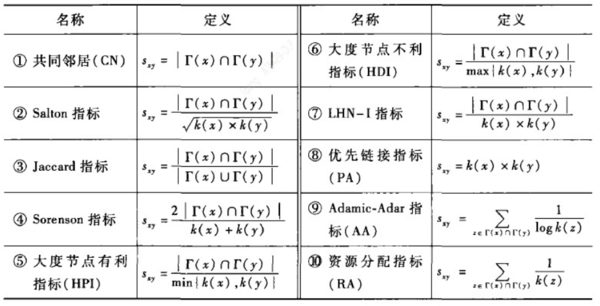本文将对图学习中的链路预测任务进行系统性的介绍。
文章目录
1. 问题定义
早期论文,证明链路预测任务的重要性:(2003 CIKM) The Link-Prediction Problem for Social Networks1
2. 研究方法
2.1 基于图中结构相似性的链路预测
在社交网络中可能符合这一假设,在PPI网络中可能不符(有很多共同邻居的蛋白质相连(interact)可能性更低)2
2.1.1 基于局部信息的相似性指标

- 共同邻居 Common neighbors
- 直接基于共同邻居指标的不同的规范化而得到的, k ( x ) = ∣ Γ ( x ) ∣ k(x) = |Γ(x)| k(x)=∣Γ(x)∣ 为节点x的度
相关早期工作:
- (2003 CIKM) The Link-Prediction Problem for Social Networks
- (2009 The European Physical Journal B) Predicting missing links via local information
- (2016 ICDE) Link prediction in graph streams
2.1.2 基于路径的相似性指标
2.1.3 基于随机游走的节点相似性指标
2.2 基于似然分析的链路预测
2.3 基于机器学习的链路预测
2.4 进行节点表征,用节点表征相似性实现链路预测:不同的相似度
一般范式是首先进行节点表征(可以有监督或无监督,解耦或耦合),然后用相似度度量指标(一般用点积或余弦相似度),用这个得分作为二分类(是否连边)任务的得分。
2.4.1 通用节点表征工作
使用余弦相似度的工作:
- GATNE3

使用内积的工作:
- VGAE4

(对取出的边还要分别过sigmoid,在本博文中略)
G2G5使用KL散度(这个是无监督节点表征模型,本来就以KL散度为基础建立的损失函数)

2.4.2 链路预测工作
DEAL6则是几种距离都测试过(点积/余弦相似度/欧氏距离),在论文中说余弦相似度效果最好(以下代码摘自https://github.com/working-yuhao/DEAL/blob/master/model.py:
class Hidden_Layer(nn.Module): #Hidden Layer, Binary classification
def __init__(self, emb_dim, device,BCE_mode, mode='all', dropout_p = 0.3):
super(Hidden_Layer, self).__init__()
self.emb_dim = emb_dim
self.mode = mode
self.device = device
self.BCE_mode = BCE_mode
self.Linear1 = nn.Linear(self.emb_dim*2, self.emb_dim).to(self.device)
self.Linear2 = nn.Linear(self.emb_dim, 32).to(self.device)
x_dim = 1
self.Linear3 = nn.Linear(32, x_dim).to(self.device)
if self.mode == 'all':
if self.BCE_mode:
self.linear_output = nn.Linear(x_dim+ 3, 1).to(self.device)
else:
self.linear_output = nn.Linear(x_dim+ 3, 2).to(self.device)
else:
self.linear_output = nn.Linear(1, 2).to(self.device)
self.linear_output.weight.data[1,:] = 1
self.linear_output.weight.data[0,:] = -1
self.cos = nn.CosineSimilarity(dim=1, eps=1e-6)
self.pdist = nn.PairwiseDistance(p=2,keepdim=True)
self.softmax = nn.Softmax(dim=1)
self.elu = nn.ELU()
assert (self.mode in ['all','cos','dot','pdist']),"Wrong mode type"
def forward(self, f_embs, s_embs):
if self.mode == 'all':
x = torch.cat([f_embs,s_embs],dim=1)
x = F.rrelu(self.Linear1(x))
x = F.rrelu(self.Linear2(x))
x = F.rrelu(self.Linear3(x))
cos_x = self.cos(f_embs,s_embs).unsqueeze(1)
dot_x = torch.mul(f_embs,s_embs).sum(dim=1,keepdim=True)
pdist_x = self.pdist(f_embs,s_embs)
x = torch.cat([x,cos_x,dot_x,pdist_x],dim=1)
elif self.mode == 'cos':
x = self.cos(f_embs,s_embs).unsqueeze(1)
elif self.mode == 'dot':
x = torch.mul(f_embs,s_embs).sum(dim=1,keepdim=True)
elif self.mode == 'pdist':
x = self.pdist(f_embs,s_embs)
if self.BCE_mode:
return x.squeeze()
# return (x/x.max()).squeeze()
else:
x = self.linear_output(x)
x = F.rrelu(x)
# x = torch.cat((x,-x),dim=1)
return x
def evaluate(self, f_embs, s_embs):
if self.mode == 'all':
x = torch.cat([f_embs,s_embs],dim=1)
x = F.rrelu(self.Linear1(x))
x = F.rrelu(self.Linear2(x))
x = F.rrelu(self.Linear3(x))
cos_x = self.cos(f_embs,s_embs).unsqueeze(1)
dot_x = torch.mul(f_embs,s_embs).sum(dim=1,keepdim=True)
pdist_x = self.pdist(f_embs,s_embs)
x = torch.cat([x,cos_x,dot_x,pdist_x],dim=1)
elif self.mode == 'cos':
x = self.cos(f_embs,s_embs)
elif self.mode == 'dot':
x = torch.mul(f_embs,s_embs).sum(dim=1)
elif self.mode == 'pdist':
x = -self.pdist(f_embs,s_embs).squeeze()
return
#(DEAL模型中,三个layer分别是上面那个类的实例)
def evaluate(self, nodes,data, lambdas=(1,1,1)):
node_emb = self.node_emb(torch.arange(self.node_num).to(self.device))
first_embs = node_emb[nodes[:,0]]
sec_embs = node_emb[nodes[:,1]]
res = self.node_layer(first_embs,sec_embs) * lambdas[0]
node_emb = self.attr_emb(data)
first_embs = node_emb[nodes[:,0]]
sec_embs = node_emb[nodes[:,1]]
res = res + self.attr_layer(first_embs,sec_embs)* lambdas[1]
first_nodes = nodes[:,0]
first_embs = self.attr_emb(data)[first_nodes]
sec_embs = self.node_emb(torch.LongTensor(nodes[:,1]).to(self.device))
res = res + self.inter_layer(first_embs,sec_embs)* lambdas[2]
return res
2.5 其他
- 利用子图结构
- WLNM:将所有子图切成相同大小输入全连接神经网络
- SEAL7:学习启发式方法(利用子图、浅嵌入和特征)
3. 链路预测工作分类和应用
- 将链路预测任务作为无监督图表征学习的训练任务(可能说是自监督学习任务更合适)(在原论文中,是在baseline中用到了有监督图表征学习方法HAN,用链路预测来作为无监督训练的任务):(2022 SDM) Structure-Enhanced Heterogeneous Graph Contrastive Learning
- inductive场景可用的模型
4. 正文及脚注中未提及的其他参考资料
- 链路预测 - 集智百科 - 复杂系统|人工智能|复杂科学|复杂网络|自组织:这篇主要讲的是传统的链路预测工作,这里面的相关内容我还没有补完
5. 待更新(flag)
- GIN
- GAT
- (2017 IJCAI) Link Prediction with Spatial and Temporal Consistency in Dynamic Networks
- (2020 AAAI) Temporal Network Embedding with High-Order Nonlinear Information
- (2019 ICDM) Social trust network embedding
2024.1.1补充:是这样的,我好久好久好久没做链路预测了,所以一直没有更新。
现在更新一下我之前整理过但是还没看的论文,作为参考资料吧:
- (2022 CIKM) RelpNet: Relation-based Link Prediction Neural Network
- (2022 ICICICT) Link Prediction in Citation Networks: A Survey
- (2022 TELKOMNIKA) LPCNN: convolutional neural network for link prediction based on network structured features
The Link-Prediction Problem for Social Networks
可参考的笔记博文:#Paper Reading# The Link Prediction Problem for Social Networks_John159151的博客-CSDN博客 看了一下这篇笔记,大致来说,这篇文章构建了一个无特征的学术合作网络,基于上一时间点(年份)预测下一时间点的新边。使用经典的节点相似性计算方法。
(表格画得跟统计学论文一样啊) ↩︎(2019 Nature Communications) Network-based prediction of protein interactions ↩︎
(2019 KDD) Representation Learning for Attributed Multiplex Heterogeneous Network ↩︎
(2016 NIPS) Variational Graph Auto-Encoders ↩︎ ↩︎
(2018 ICLR) Deep Gaussian Embedding of Graphs: Unsupervised Inductive Learning via Ranking
我写过笔记:Re37:读论文 G2G Graph2Gauss Deep Gaussian Embedding of Graphs: Unsupervised Inductive Learning via Rank ↩︎(2020 IJCAI) Re9:读论文 DEAL Inductive Link Prediction for Nodes Having Only Attribute Information ↩︎ ↩︎
(2018 NIPS) Link prediction based on graph neural networks
我参考了如下资料:
①论文分享|基于GNN的链路预测 - 知乎:这篇写得挺抽象的,不作推荐 ↩︎






















 2万+
2万+

 被折叠的 条评论
为什么被折叠?
被折叠的 条评论
为什么被折叠?










